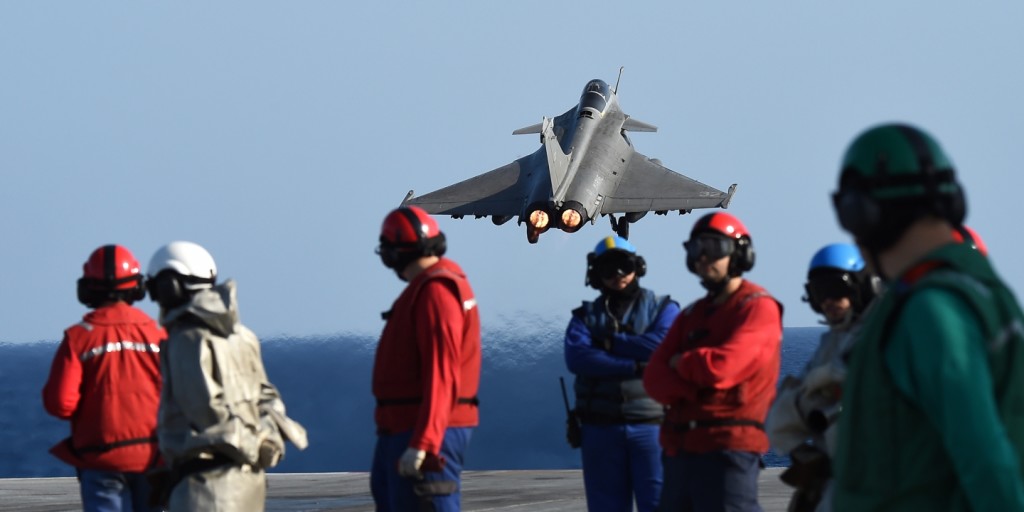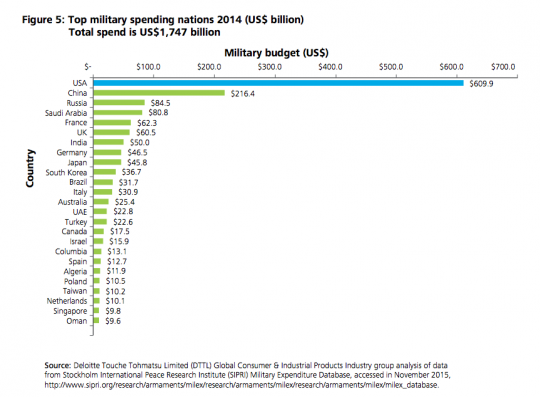Defense Industry Revenue Forecast Gushes over Global Turmoil
MILITARISM, 11 Jan 2016
9 Jan 2016 – The global aerospace and defense industry is out of its doldrums. According to a new report by the accounting firm Deloitte, “the resurgence of global security threats” promises a lucrative “rebound” in defense spending.

A French Rafale fighter aircraft takes off with bombs from the French aircraft carrier Charles-de-Gaulle on Nov. 23, 2015, in the eastern Mediterranean Sea, as part of Operation Chammal in Syria and Iraq against the Islamic State. Photo: Anne-Christine Poujoulat/AFP/Getty Images
The report alerts investors that “revenue growth” is “expected to take a positive turn” due to the terrorism and war in the Middle East and the tensions in Eastern Europe and the South China Sea.
Many analysts predicted declining revenue for the weapons industry as the U.S. scaled down military involvement in Iraq and Afghanistan. After all, as this chart from the Deloitte report shows, no other country even comes close to spending as much as the U.S. does.
But now governments around the world have moved swiftly to hike defense budgets to “combat terrorism and address sovereign security matters.”
The Deloitte report is almost giddy:
2015 was a pivotal year that saw heightened tensions between China, its neighbors and the US over “island building” in the South and East China Seas, and the related claims of sovereign ocean territory rights by China. In addition, Russia and the Ukraine are at odds related to Russia’s takeover of Crimea and their military actions in Eastern Ukraine. North Korea continues to threaten its neighbors with its nuclear ambitions and aggressive rocket launches. The Islamic State (ISIS) has become a key threat in Syria, Iraq, and Afghanistan and is involved in exporting terrorism to Europe, Africa, and elsewhere. The recent tragic bombings in Paris, Beirut, Mali, the Sinai Peninsula, and other places have emboldened nations to join in the fight against terrorism.
Several governments affected by these threats are increasing their defense budgets to combat terrorism and address sovereign security matters, including cyber-threats. For defense contractors, this represents an opportunity to sell more equipment and military weapons systems. Products, which are expected to experience renewed interest from buyers, include armored ground vehicles, ground attack munitions, light air support aircraft, intelligence, surveillance and reconnaissance electronic sensors, cyber protections, maritime patrol ships and aircraft, as well as provision for equipment maintenance and sustainment, as the military operations tempo is likely to increase and more missions are executed.
It is expected that a return to growth for defense subsector companies will likely occur, due to the increased interest by several involved nations as described above. In addition, many large, mainly US DoD defense programs representing billions of US dollars, are likely to start soon, enter the engineering manufacturing design phase, and reach low-rate or full-scale production over the next few years. These programs include Ohio Class Submarine replacement, F-35 fighter jet, KC-46A aerial refueling tanker, Long Range Strike Bomber, USAF T-X trainer, and Rafale fighter programs.
As for factors that might slow the global arms race, the report says little about diplomacy or peace movements. It does note that the fall in oil prices might eventually blunt the weapons-buying trend in the Persian Gulf, although not anytime soon.
In the U.S., as we’ve reported, defense contractors have bragged about pushing candidates toward adopting more militaristic policies. The libertarian trend in the Republican Party, for instance, has largely reversed itself and most candidates have adopted increasingly hawkish views.
______________________________
Lee Fang: ✉lee.fang@theintercept.com
Go to Original – theintercept.com
DISCLAIMER: The statements, views and opinions expressed in pieces republished here are solely those of the authors and do not necessarily represent those of TMS. In accordance with title 17 U.S.C. section 107, this material is distributed without profit to those who have expressed a prior interest in receiving the included information for research and educational purposes. TMS has no affiliation whatsoever with the originator of this article nor is TMS endorsed or sponsored by the originator. “GO TO ORIGINAL” links are provided as a convenience to our readers and allow for verification of authenticity. However, as originating pages are often updated by their originating host sites, the versions posted may not match the versions our readers view when clicking the “GO TO ORIGINAL” links. This site contains copyrighted material the use of which has not always been specifically authorized by the copyright owner. We are making such material available in our efforts to advance understanding of environmental, political, human rights, economic, democracy, scientific, and social justice issues, etc. We believe this constitutes a ‘fair use’ of any such copyrighted material as provided for in section 107 of the US Copyright Law. In accordance with Title 17 U.S.C. Section 107, the material on this site is distributed without profit to those who have expressed a prior interest in receiving the included information for research and educational purposes. For more information go to: http://www.law.cornell.edu/uscode/17/107.shtml. If you wish to use copyrighted material from this site for purposes of your own that go beyond ‘fair use’, you must obtain permission from the copyright owner.
